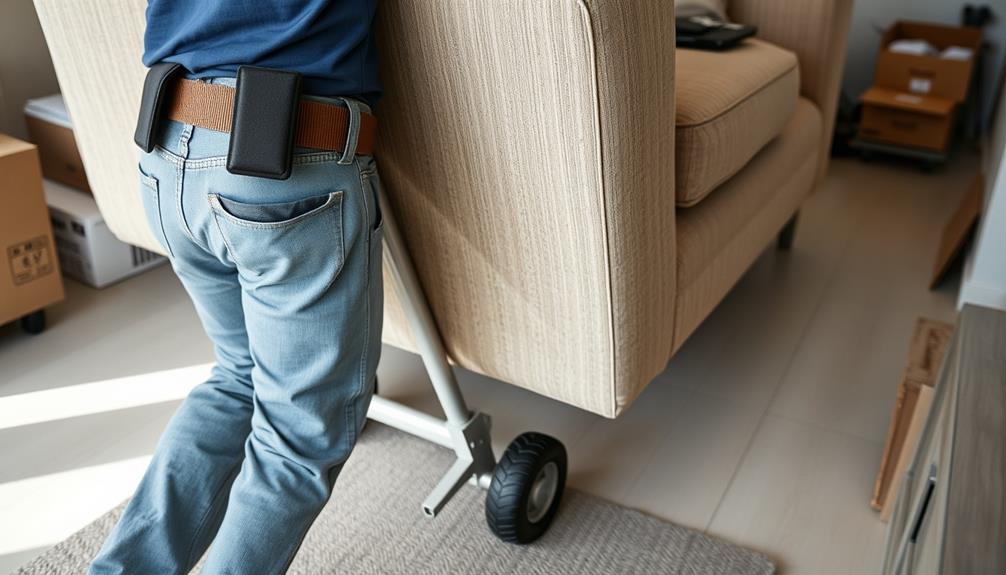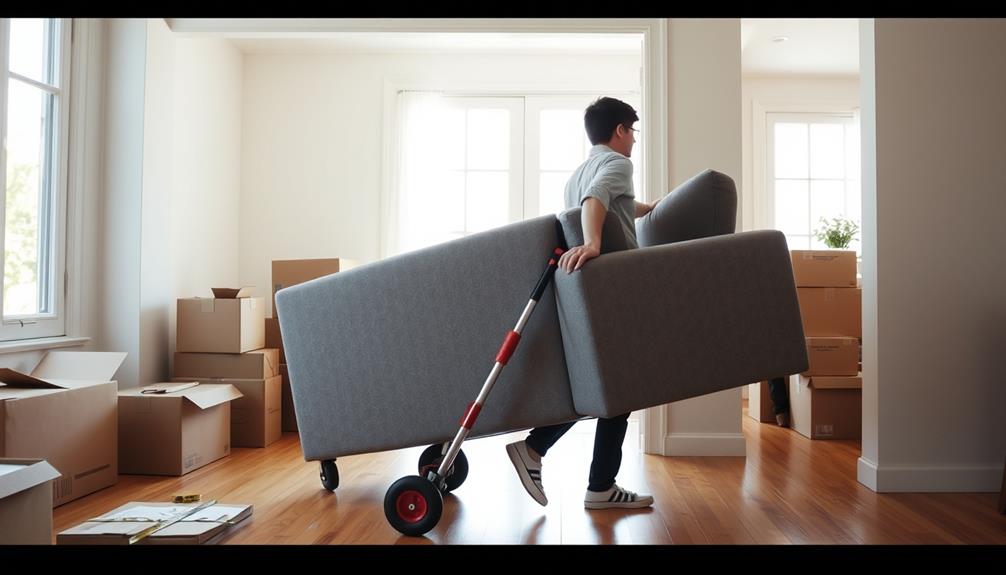To successfully move heavy furniture on your own, it is important to have a well-thought-out plan in place. Begin by measuring both the furniture and doorways to ensure a smooth path, and gather the necessary tools such as furniture sliders and dollies. Be sure to wear protective gear, including gloves and sturdy shoes. When lifting the furniture, remember to keep it close to your body and use your legs to avoid straining your back. Remember to take frequent breaks and stay hydrated throughout the process. If you encounter stairs, consider disassembling items to make transportation easier. To prevent damage to your floors and furniture, use blankets or pads as protection while moving. There is always more to learn about improving the efficiency of this process.
Key Takeaways
- Measure furniture and doorways to ensure a clear path, and plan your moving route to avoid obstacles.
- Utilize furniture sliders or dollies to reduce strain and facilitate movement of heavy items more easily.
- Disassemble large furniture pieces when possible to lighten the load and simplify transport.
- Wear protective gear, including sturdy shoes and gloves, to minimize injury risk during the move.
- Take regular breaks to maintain energy levels and avoid overexertion while lifting heavy objects.
Planning and Preparation
When you're moving heavy furniture by yourself, effective planning and preparation are essential for a successful move. Start by measuring the dimensions of both your furniture and the doorways or hallways. This guarantees you have a clear path and prevents getting stuck during the move.
Additionally, consider incorporating primitive weapon techniques that enhance your self-reliance and adaptability in challenging situations, as these skills can also aid in problem-solving during the moving process. Create a detailed plan that outlines the route for each piece of furniture, noting any obstacles or tight spaces you might encounter along the way.
Next, gather essential tools like furniture sliders, dollies, and lifting straps. Having these on hand will facilitate the moving process and reduce strain on your body.
Before you start moving, clear the pathways of any obstacles, including rugs, clutter, and other furniture. This minimizes tripping hazards and allows for a smoother experience.
Safety Precautions
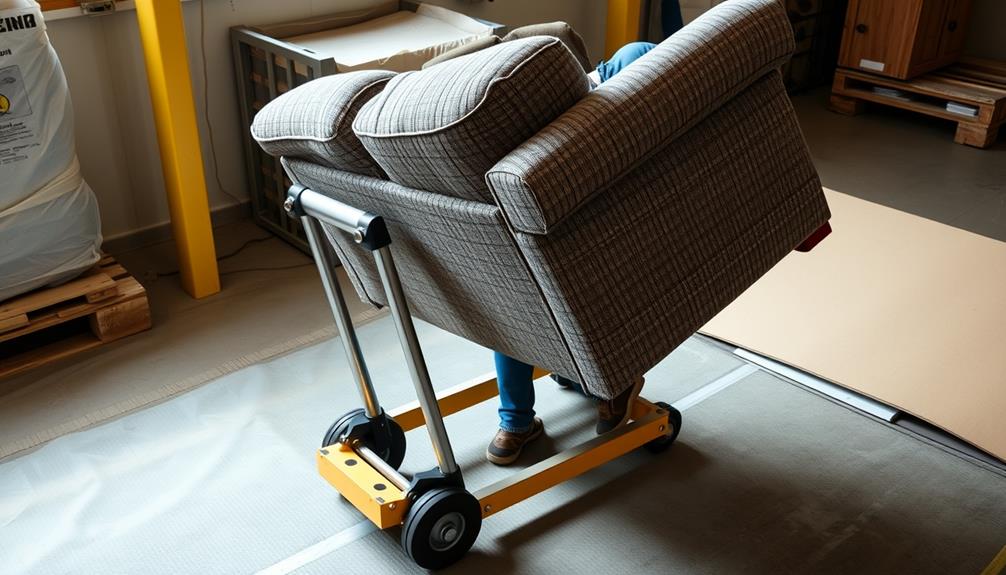
When moving heavy furniture, it's essential to assess your limitations to avoid injury.
Make certain you wear protective gear to shield yourself from potential accidents, and don't forget to stay hydrated throughout the process.
Additionally, consider using tools and techniques that can ease the strain on your body, much like how proper cold medication usage can alleviate discomfort during illness.
Taking these safety precautions will help guarantee a smoother and safer move.
Assess Your Limitations
Before you engage in moving heavy furniture, it's crucial to assess your limitations to guarantee your safety. Start by evaluating the weight of the item; if it exceeds 250 pounds, it's wise to seek assistance to avoid injury.
Recognize your physical limitations—if you feel discomfort or fatigue at any point, stop moving to prevent strain or accidents. Additionally, it may be beneficial to develop a plan for managing your moving process, similar to how one would create a budget for financial health.
Utilize proper lifting techniques: bend your knees, keep the object close to your body, and lift with your legs. This approach helps reduce the risk of back injuries, which can sideline you for weeks.
Throughout the process, take regular breaks; this not only allows your body to recover but also helps prevent overexertion.
Always keep a first aid kit accessible during your move, so you're prepared for any injuries that may occur. Make sure your phone is nearby as well, allowing you to call for help if needed.
Wear Protective Gear
Moving heavy furniture requires not only careful planning and awareness of your limitations but also the right protective gear to keep you safe.
Start by wearing sturdy, closed-toed shoes with a good non-slip grip. This is essential to prevent slips and falls while you're maneuvering bulky items.
Don't forget to put on protective gloves, as they can improve your grip and shield your hands from scrapes and blisters.
Choose light, breathable fabrics to enhance comfort and mobility during the move, while keeping your clothing close-fitting to avoid snags on furniture.
If you're lifting or sliding particularly heavy pieces, consider using knee pads for extra protection, which can greatly reduce the risk of injury.
As you move, remember to keep your back straight and avoid twisting your body to maintain proper posture.
Lastly, always have a first aid kit accessible during the move to address any injuries that may occur, ensuring a safe moving environment.
Stay Hydrated Always
Hydration is essential for maintaining your strength and stamina while tackling the physically demanding task of moving heavy furniture. To avoid dehydration, make it a priority to stay hydrated throughout the process. Aim to drink at least 8 ounces of water every hour, and increase that amount if you're in hot or humid conditions.
Keep a water bottle readily accessible to encourage regular hydration breaks. Signs of dehydration, like a dry mouth, headache, or decreased urine output, can sneak up on you, so it's important to monitor your body's signals. Ignoring these signs can lead to fatigue and decreased strength, making your task even harder.
In addition to plain water, consider consuming electrolyte-rich beverages. These can help maintain your energy levels and prevent muscle cramps during strenuous activities.
Proper Lifting Techniques
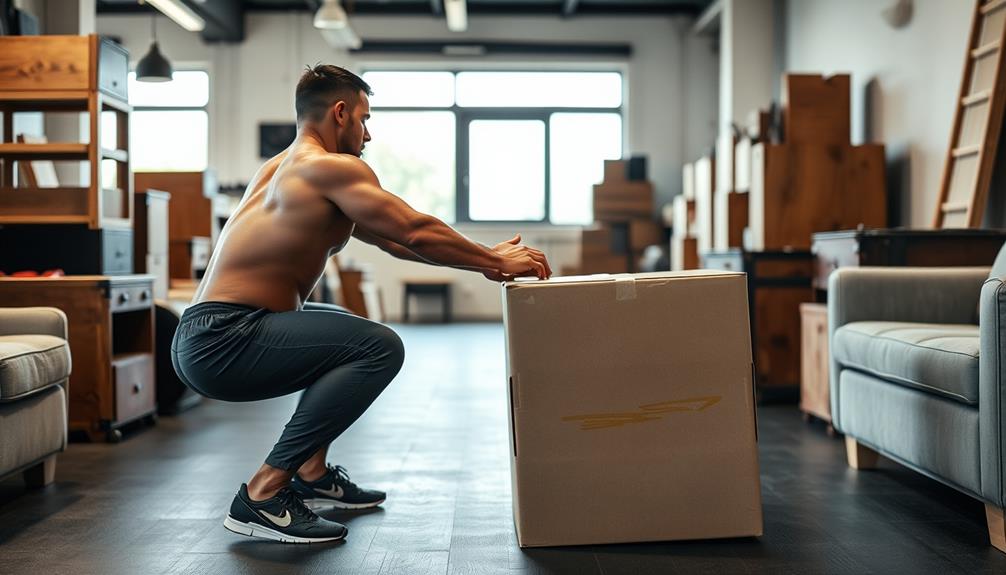
Proper lifting techniques are vital for anyone attempting to move heavy furniture alone. To start, always lift with your legs by bending your knees while keeping your back straight. This approach minimizes the risk of injury and utilizes your strongest muscles.
When you're ready to lift, keep the object close to your body; this helps maintain balance and reduces strain on your back and arms. As you carry the item, avoid twisting your body. Instead, pivot with your feet to change direction while maintaining good posture.
It's important to secure a firm grip on the furniture, using handles or lifting straps. This prevents slips and guarantees you have better control over the item.
Don't forget to take breaks as needed, especially when moving heavy items alone. This practice helps prevent fatigue and allows you to maintain proper lifting techniques throughout the process.
Essential Tools and Equipment
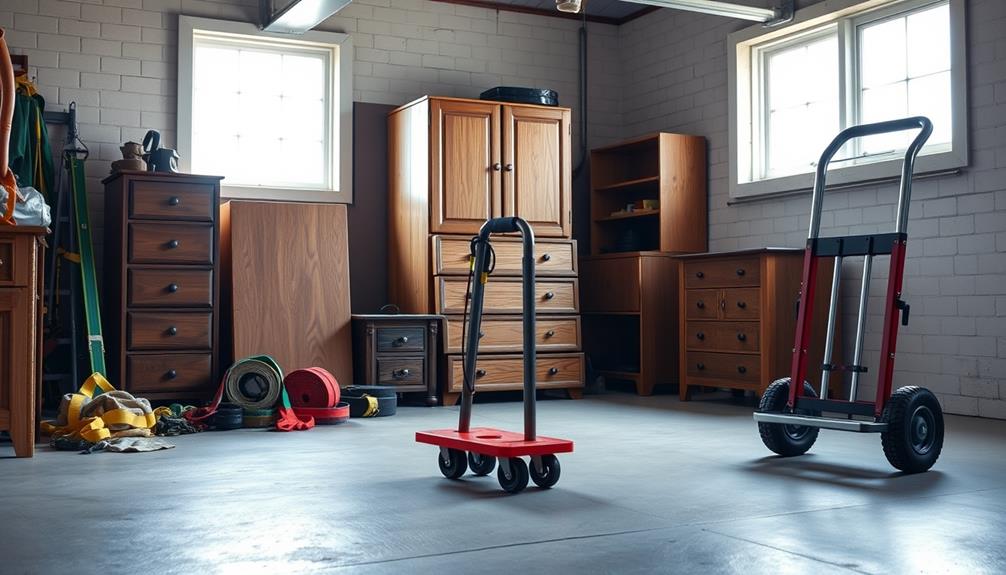
Having the right tools can make a significant difference when moving heavy furniture by yourself. Utilizing the right equipment not only simplifies the process but also enhances safety. Here's a quick overview of essential tools you should consider:
| Tool | Purpose | Benefits |
|---|---|---|
| Moving Dollies | Transport heavy furniture | Easier maneuvering, injury reduction |
| Furniture Sliders | Glide furniture across floors | Minimal effort, protects floors |
| Lifting Straps | Distribute weight evenly | Reduces strain on your back |
| Gloves | Improve grip and protect hands | Safer handling, prevents injuries |
| Blankets/Furniture Pads | Serve as protective barriers | Prevents scratches and damage |
Using moving dollies can help you transport heavy items without straining yourself. Furniture sliders make it easy to glide furniture across hardwood or tile floors. Lifting straps allow you to lift with less strain, while gloves protect your hands during heavy lifting. Finally, blankets and furniture pads act as protective barriers, ensuring your furniture and floors remain damage-free. By equipping yourself with these moving supplies, you'll make your heavy furniture move smoother and safer!
Moving Furniture on Stairs
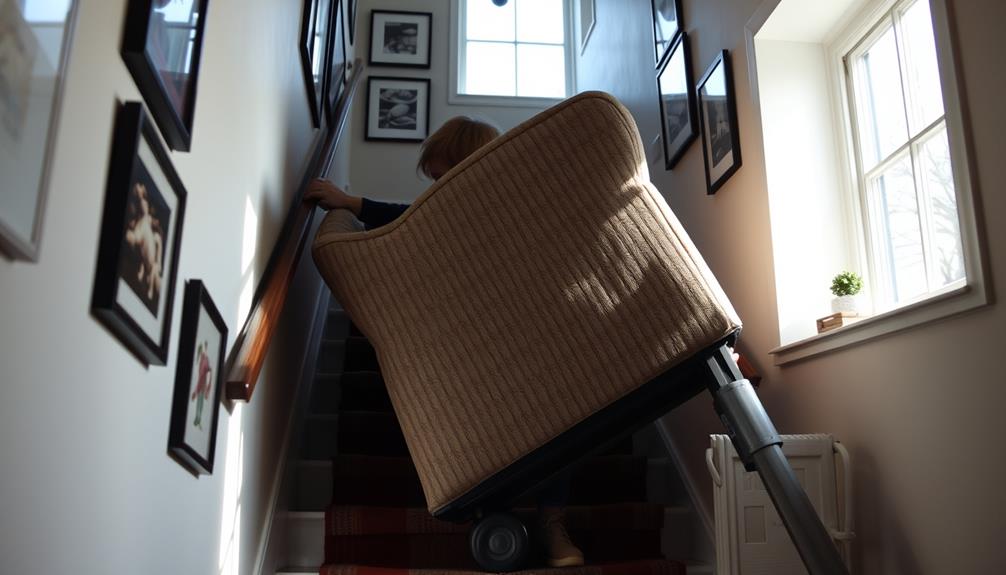
Moving heavy furniture on stairs can be one of the most challenging aspects of relocating. Before you start, assess the weight and dimensions of each piece. If possible, disassemble the furniture to lighten the load.
For better weight distribution, utilize a stair dolly or moving straps, with one person at the top and one at the bottom to maintain control.
When moving furniture upstairs, position the heavier end facing up the stairs to keep balance. Move in slow, deliberate steps to prevent accidents.
If you're descending, employ the walking backwards technique—face the stairs with the furniture in front of you and use your legs to absorb the impact.
Always secure handrails and check the stability of stairs before you begin; this'll help you avoid potential hazards.
Protecting Furniture and Premises
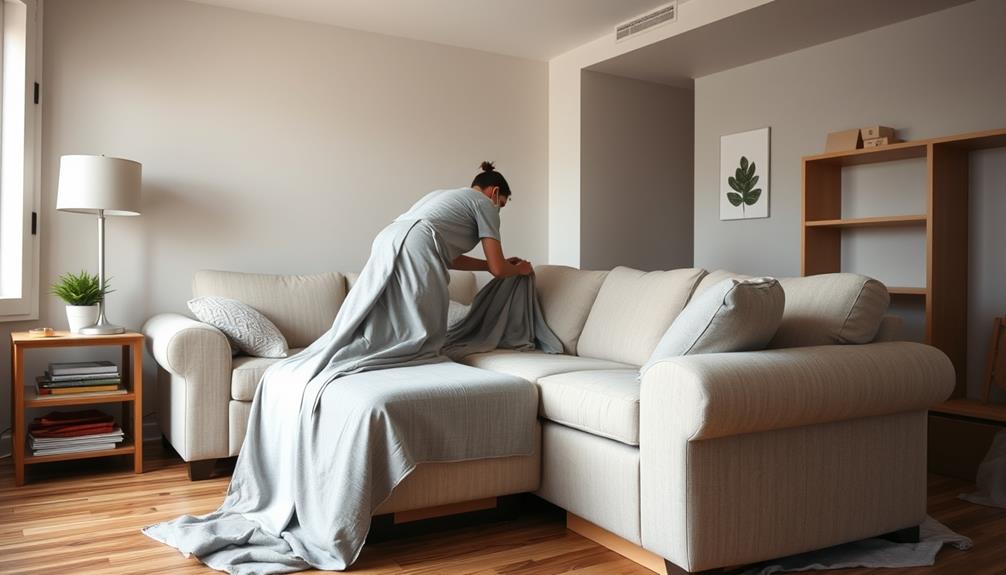
How can you guarantee your furniture and home stay safe during a move? Start by wrapping heavy furniture in moving blankets or bubble wrap to prevent scratches and damage, especially on delicate surfaces like wood or glass.
For upholstered items, use plastic covers to protect against dirt and moisture.
Next, employ furniture pads or felt glides underneath heavy pieces to avoid scratching your floors as you're moving furniture. This simple step can save you from costly repairs later on.
Don't forget to tape cardboard to your walls, particularly at corners, to prevent dents and scuffs from furniture edges during transport.
Additionally, old blankets or sheets can serve as makeshift covers to add an extra layer of protection for both your furniture and the surrounding premises.
These materials help cushion your items and keep surfaces safe while you're busy moving.
Tips for Disassembly and Lightening Load
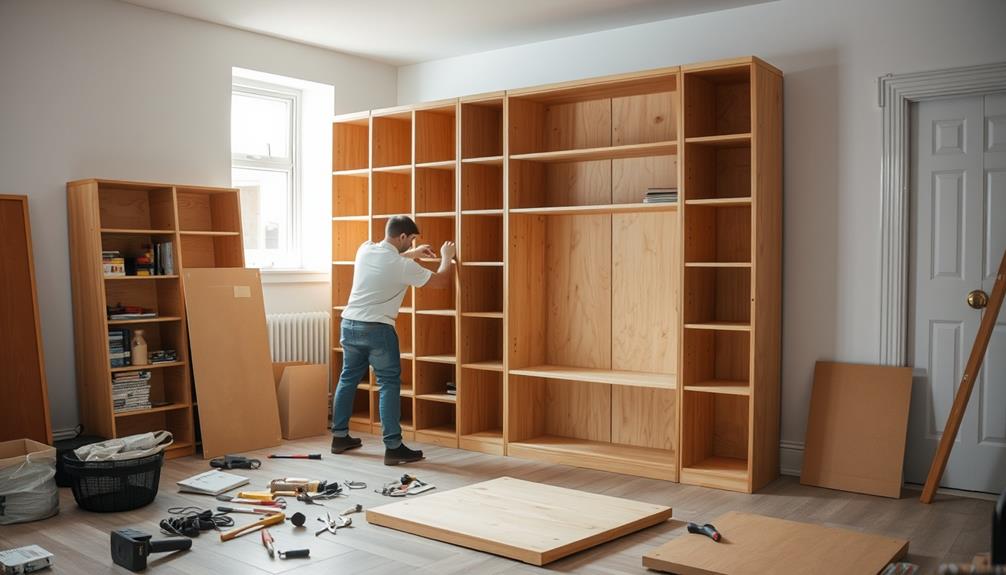
When you're tackling heavy furniture, start by removing any detachable components to lighten the load.
Organizing small parts is essential, so keep screws and brackets in labeled bags for easy access later.
Remove Detachable Components
Disassembling furniture can noticeably lighten your load and make the moving process smoother. Start by removing detachable components, like drawers from dressers or desks. This greatly reduces weight and makes them easier to maneuver. Detaching legs from tables, dressers, and bedframes also helps, allowing you to fit through doorways without hassle. Additionally, if you have a large dining table, take out any leaves to simplify transport.
When you disassemble, use the right tools—like screwdrivers or drills—to promote efficiency and prevent damage to your furniture pieces. It's crucial to keep everything organized during disassembly. Store screws and small hardware in labeled bags for easy reassembly later on.
Here's a quick reference table for effective disassembly:
| Component | Action | Benefit |
|---|---|---|
| Drawers | Remove | Reduces weight |
| Legs | Detach | Easier transport |
| Table leaves | Take out | Simplifies moving |
| Screws & hardware | Label and store | Prevent loss |
| Tools | Use appropriate ones | Promote damage-free disassembly |
Taking these steps will help you move efficiently and protect your furniture.
Organize Small Parts
Organizing small parts during disassembly is essential for a smooth moving experience. When you disassemble heavy furniture, start by removing detachable components like legs, shelves, or drawers. This not only lightens the load but also makes handling the pieces easier.
As you take apart the furniture, keep screws and bolts organized in labeled bags. This way, you won't lose any small parts, and reassembly will be a breeze.
Make certain you have the right tools, like a screwdriver or drill, to efficiently disassemble your furniture. Using the proper tools helps avoid damage to both the furniture and your walls.
Before you start, consider snapping a few photos of the furniture to serve as a reference for assembly later. This visual guide will help you remember how everything fits together.
Lastly, factor in the time needed for disassembly and assembly in your moving plan. This will prevent delays and guarantee you stay on track during your move.
Use Proper Tools
Using the right tools can make a significant difference in your furniture disassembly process. When you disassemble larger pieces, you can lighten the load and make moving furniture much easier. Here are some essential tools and tips to help you:
- Screwdrivers or Power Drills: Use proper tools for disassembly to minimize damage while removing legs or shelves. Invest in both flathead and Phillips screwdrivers for versatility.
- Furniture Sliders: Consider utilizing furniture sliders under heavy items. They reduce friction, making it easier to slide furniture across the floor without damaging it.
- Labeled Bags: Keep screws and small parts organized in labeled bags during disassembly. This organization guarantees you can easily reassemble everything later without confusion.
- Empty Drawers and Cabinets: Lighten the load further by removing non-essential items, such as drawers from dressers or contents from cabinets. This not only makes the furniture lighter but also minimizes the risk of damage during the move.
Frequently Asked Questions
How Do You Move Super Heavy Furniture by Yourself?
When you need to shift super heavy furniture, consider using a dolly or sliders. Disassemble large pieces, clear pathways, and utilize lifting straps to distribute weight and protect your back while maneuvering through tight spaces.
How to Move a Heavy Object Alone?
Imagine struggling to lift a bulky object alone, feeling overwhelmed. To move a heavy object, use furniture sliders to reduce friction. Plan your path and consider disassembling it for easier handling and control.
How to Easily Slide Heavy Furniture?
To easily slide heavy furniture, use furniture sliders suited for your flooring type. Push from the lower section for better control, maintain a steady pace, and protect your floors with moving blankets or cardboard underneath.
How to Move Heavy Furniture on Carpet by Yourself?
To move heavy furniture on carpet, use furniture sliders or a moving dolly designed for carpets. If those aren't available, try placing a thick blanket underneath to glide the item more easily. Engage your legs when lifting.
Conclusion
Moving heavy furniture by yourself can be a challenging task, but with the right planning and techniques, you can tackle it safely and efficiently. Did you know that nearly 33% of all injuries related to moving involve lifting heavy objects? By using proper lifting techniques and essential tools, you can minimize your risk of injury. So, take your time, follow the tips outlined, and remember that a little preparation goes a long way in making your move smoother. Here are some helpful tips for lifting heavy furniture. First, always remember to lift with your legs and not your back to avoid strain. Second, consider using furniture sliders or dollies to make the process easier. Lastly, it’s important to ask for help if the item is too heavy or awkward to lift on your own. Following these tips will help make your move a success and keep you safe from unnecessary injuries.
